1. Structure a WINNING Introduction

Chapter 1 needs to be excellent. As in all beginnings, it needs to engage its audience – your examiners, supervisors, advisors and subsequent readers – and convince them of the value of your research.
It has multiple other tasks: it must set the scene for your research, with sections on the background and foreground of the research problem, the problem and purpose statements, and the research question(s). It also needs to refer to relevant research literature at a high level, and to clarify its contribution to knowledge.
Usually, your school or supervisor provides you with a structure for writing the introduction chapter. If so, you should always defer to that.
But if you’re searching for a structure to write the introduction chapter of your dissertation, the following layout may help you. It is based on the work of various methodologists (Badenhorst, 2017; Creswell, 2014; the National Research Council, 2002; Van de Ven, 2007).
Here is the bare-bones version of the structure:
- Background of the problem
- Foreground of the problem
- Associated research literature (at a high level)
- Problem statement
- Purpose statement/ research objectives
- Research question and sub-questions
- Scope of the research
- Contribution to knowledge
- Layout of the following chapters.
Do you need help with your Introduction chapter?
Contact [email protected]
Sources
Badenhorst, C. (2007). Research writing: Breaking the barriers. Pretoria, South Africa: Van Schaik Publishers.
Creswell, J. W. (2014). Research design: Qualitative, quantitative, and mixed methods approaches (4th ed.). London, UK: Sage.
National Research Council. (2002). Scientific research in education. Committee on Scientific Principles for Education Research. Shavelson, R. J., and Towne, L., Eds. Center for Education. Division of Behavioral and Social Sciences and Education. Washington, DC: National Academy Press.
Van de Ven, A. H. (2007). Engaged Scholarship. Oxford, UK: Oxford University Press.
2. 5 Dissertation TRAPS: How to avoid them
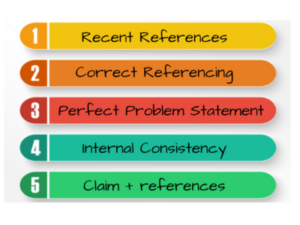
There are certain parts of a proposal, dissertation or thesis that often trip students up early on.
Let me share 5 of them with you (in no particular order).
First off, is the trap of outdated references.
The rule of thumb is that over 80% of your references should be newer than 5 years old (unless you’re researching a historical topic). It’s particularly serious when you cite an outdated reference and imply that it represents a current viewpoint.
A remedy is to specify a date range in your literature searches, e.g., 2018 onwards. Or find newer sources that reference an older article. Google Scholar provides these options, as do other search engines.
The second trap is sloppy referencing.
This is where in-text references are missing, or where in-text references don’t tie up with the reference list, and vice versa.
The remedy here is to use a referencing tool, e.g., Mendeley Cite, Zotero, or EndNote. With these, you can insert your in-text references correctly as you write, and avoid errors in your reference list. This will save you many unnecessary hours later.
The third trap is a poor Problem Statement.
Students often confound the various sections of the Introduction chapter. For example, they provide a Problem Statement of several pages that states the background of the problem at length without specifying the actual problem that needs to be researched.
A remedy for a good problem statement is to place it after the sections specifying the Background/Introduction, the Foreground/Research Problem, and the high-level debates in the Research Literature. Then the problem statement briefly summarises these three previous sections, and also states the knowledge gap and the rationale for your research. It does all this in a succinct paragraph of ½ – ⅔ of a page.
The fourth trap is internal inconsistency in your document.
Very often, the problem, research objectives/purpose of the research, and the research questions are not aligned, and so the document makes inconsistent promises.
A remedy is to review your own document and highlight every time you’ve said what the research is going to achieve. Then copy and paste these highlighted bits to a page, look for inconsistencies, and correct them. It will clear your thought processes too.
The fifth trap is focusing on who said what in your writing.
This is where each paragraph starts with the authors’ names and states what they say, or says, “According to ….”.
The remedy here is to focus on what is said, i.e., the claim, and then place the reference in brackets at the end of the claim, i.e., claim + references. This will uplift the conceptual level of your writing.
Do you need help checking your dissertation or thesis?
Contact [email protected]
3. Is Your Dissertation STRONG?

A dissertation or thesis is somewhat like a chain – a chain of interlinked stages from the identification of the problem to the conclusion.
Of course, you can revisit and improve a previous stage.
Nevertheless, a dissertation or thesis IS ONLY AS STRONG AS ITS WEAKEST STAGE, just like a chain that’s only as strong as its weakest link.
Let’s review the main stages of a dissertation in their usual order:
First, you identify a research problem.
Second, you review relevant literature on your topic, identify the theoretical and conceptual frameworks and a knowledge gap.
Third, you frame appropriate research question(s) to address the knowledge gap.
Fourth, you identify a research design that can answer the research question(s).
Fifth, you identify your population and sampling methodology.
Sixth, you collect your data.
Seventh, you analyse your data.
Finally, you answer your research question(s) in relation to theory, acknowledge the strengths and weaknesses of your research, and recognise opportunities for future research.
The message here is that ANY ONE OF THESE STAGES CAN BE A WEAK LINK AMONG OTHER STRONG ONES. Sadly, that’s the link that will compromise your thesis, and probably the one that you’ll remember your thesis by. (It’s also possible that more than one of your stages is weak, but let’s not go there.)
So, devote your energies to each and every stage, and you’ll deliver a dissertation or thesis to be proud of.
Do you need help with your dissertation or thesis?
Contact [email protected]
4. Boost your literature review
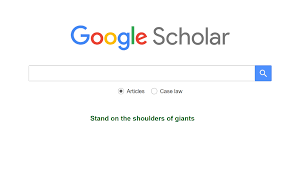
If you don’t know where to start your literature review, or you want to check up on your list of sources, Google Scholar is there for you!
Google Scholar is very helpful for a student doing a dissertation or thesis, as it combines information from many sources, including books, articles, theses, conference papers etc. And it’s easy to use.
You can access it via Google in the apps (under ‘More’). It offers a Library Links setting so that you can link to your school’s library for accessing sources that aren’t directly available on Google Scholar.
You can start by putting in your main keywords and asking for recent sources. And once you see how easy it is to use, you can do advanced searches.
It’s easy but very sophisticated, and Google can give you more and more precise searches as you go along.
Here’s are two links on how to use Google Scholar:
Do you need help with using Google Scholar?
Contact [email protected]
5. Improve how you write your literature review
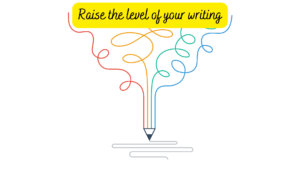
In my experience, most students write their literature reviews by focusing on who (i.e. the authors of each reference) says what. Each paragraph starts with authors’ names. Writing this way is not ideal as the focus is on the authors, rather than on what they’re saying. According to Bloom’s (2001) Taxonomy of conceptual levels, students who write this way are merely describing and reporting what they have read, with no analysis or synthesis.
The following paragraph provides an example of writing that focuses on what the authors say. The context is the benefits and challenges of a 4-day working week:
Author 1 presents findings that showed that employees who work a 4-day week felt that the organisation cared about their well-being. According to Author 1, employees were more focused on their work. Author 2 makes a similar observation. Author 3 concurs as they found that employees working a 4-day week arranged fewer and shorter meetings so that they could finish their work in a shorter time. Author 4 posits that workers will be fatigued and unable to keep up the pace required to finish their work in the reduced hours. Furthermore, Author 5 found tensions between employees in knowledge-based roles who are paid monthly and those in service-based roles who are paid hourly. Similarly, Author 6 suggests that differently paid employees who work in teams will be difficult to manage in a 4-day week.
Notice how the focus in this paragraph (above) is on the authors.
Now have a look at how the same material is grouped and written below, with the focus on analysing and comparing what the authors are saying (with references). Here the emphasis is on benefits, followed by challenges. Benefits are synthesised or grouped together, as are challenges. According to Bloom’s (2001) Taxonomy, students who write this way are writing at a higher conceptual level as they successfully draw conclusions by organising, comparing and contrasting ideas.
The research literature provides evidence of both benefits and challenges associated with a 4-day work week. Benefits include employees’ perceiving their organisations as caring for their well-being, and consciously adopting a more focused, efficient approach to completing their work in fewer hours (Author 1; Author 2; Author 3). However, greater efficiency may produce challenges for employees who cannot keep up the pace required in a 4-day week, resulting in employee fatigue and burnout (Author 4). A further challenge may arise from conflict between employees in knowledge-based roles who are paid monthly, versus service-based employees who are paid hourly and cannot benefit from a reduced week (Author 5). Furthermore, managing teams of employees with different pay structures may provide an additional challenge (Author 6).
This simple strategy of organising and comparing what is being said (with references), rather than focusing on the authors and merely describing what they’ve said, raises the conceptual level of your writing.
Do you need help with your literature review?
Contact [email protected]
6. Fix your theoretical and conceptual frameworks

Many students find theoretical and conceptual framing challenging.
For starters, the terms theoretical framework and conceptual framework are often defined differently across the research methodology literature, and some methodologists don’t distinguish between them.
I follow the view of Kumar (2014) and Maxwell (2013), that the theoretical framework comprises the theories and issues of relevance to what you plan to study. On the other hand, the conceptual framework comprises the particular aspects of the theoretical framework that relate specifically to your research, and that you select from the theoretical framework to become the basis of your study.
So, according to this view, the researcher builds the conceptual framework from selected pieces of the theoretical framework, and the conceptual framework becomes the basis of your study.
Sources
Kumar, R. (2014). Research methodology: A step-by-step guide for beginners. Thousand Oaks, CA: Sage.
Maxwell, J. A. (2013). Qualitative research design: an interactive approach. Thousand Oaks, CA: Sage.
Do you need help with your conceptual framework?
Contact [email protected]
7. Grade your own dissertation or thesis for consistency

Why not assess your own dissertation or thesis for consistency?
Consistency is what helps me grade a proposal, dissertation or thesis – the consistency with which the student states the objectives of the research throughout the document.
Let me share with you how I assess this.
In my first read of a student’s work, I highlight each time they state their research objectives, purpose, aim, etc. These appear directly and indirectly many times: in the introduction, problem and purpose statements, the research question(s) and hypotheses, as well as in the methodology.
I then scroll through the highlighted bits, and assess their consistency. They must be consistent. But so many times, they aren’t.
As an example, a student may start off by stating the objective of their research as ‘Assessing the application of a policy’, but later change to measuring and testing the awareness or knowledge or perception of the policy, and not mention the application of policy thereafter.
Of course, one may have an overarching research question on the application, supported by research sub-questions on each of the different aspects of the main question. If so, this arrangement must be stated consistently throughout the document.
So do this for yourself – take a read through your document, and highlight every instance you’ve stated what your research aims to do, as well as why it will do so, and how. Then copy and paste these highlighted bits together on a page, and judge their consistency.
Hopefully, they’ll all be beautifully aligned and consistent. If they aren’t, return to these bits and make them consistent.
Do you need help checking the consistency of your literature review?
Contact [email protected]
8. Convince your examiners of the need for your research

In your early chapters, it is very important to convince your examiners of the need for your research.
One way to do this is to structure a scientific argument for your research, working from your theoretical framework to your conceptual framework.
For this, I use Van de Ven’s (2007) adaptation of the Toulmin (2003) structure of an argument. It proceeds as follows:
Describe:
- The background, context or problem for the theories you’ve selected
- The proposition or claim you’re making/ testing
- The reasons for your claim
- The evidence for these reasons
- The qualifiers/ boundary conditions or assumptions of your study
- The reservations or delimitations of your study.
Consider structuring your literature review this way, or perhaps the latter part of it in which constructing or justifying your conceptual framework.
You’ll be surprised how well it works.
Do you need help with your scientific argument?
Contact [email protected]
Source
Van de Ven, A. H. (2007). Engaged Scholarship. Oxford, UK: Oxford University Press.
9. Craft your ABSTRACT

By the time you write the abstract of your thesis or dissertation, you will need to have completed your study, finalised your results, and appreciated the implications of your findings.
And you’re probably exhausted.
However, academic formatting styles provide valuable guidance on the content and format of the abstract. These should help you over the finish line!
The APA 7 formatting style requires that your abstract be no longer than 250 words. It is placed proudly on its own page, in a single paragraph, under the heading “Abstract”, which is centered.
Then you need to write one or two brief sentences on each of the following:
First, the main aspect of the associated Research Literature; second, your Research Problem and Hypothesis/hypotheses (if applicable); third, your Study Method including your research design, sample size, materials/measurement instruments, outcome measures, procedures for gathering your data, and main analysis; fourth, your main Findings including their significance and effect size (if applicable); and fifth, the main implications or significance of your Conclusions.
Finally, add three to five Keywords (words or phrases) beneath your abstract. These should capture the essence of your research as they are used for indexing and thus helping others find your abstract in searches.
It’s really worth the effort to craft an exquisite abstract. After all, your abstract will be the focus of attention for most of your future readers.
Do you need help with your abstract?
Contact [email protected]
10. Tips for titles

How many times have you chosen to read something based on its title? Many times, I’m sure.
So, the title of your thesis or dissertation is important.
It should present your research accurately and encourage others to read it.
Here are answers to a few FAQs on academic titles:
HOW MANY WORDS SHOULD THE TITLE HAVE?
APA 7 recommends no more than 12 words, although some schools allow 10-15 words.
For example:
Modelling Interpersonal Styles of Managers via Trust and Autonomy
WHAT SHOULD THE TITLE CONTAIN?
First, it should include the purpose or topic of your study, as well as its scope. Sometimes, the scope is stated as a subtitle.
For example:
The Role of Interpersonal Factors in Management Success: A Case Study of Company X
Here, the subtitle provides the methodology and scope of the research. But check whether your school allows subtitles.
Second, it should include your keywords so that search engines will find your study.
WHAT SHOULD IT NOT CONTAIN?
It should not contain generic phrases such as “An Investigation of…”, “A Study of…”, “A Comparison of…” etc. These are a waste of precious words.
And it should not have abbreviations.
HOW SHOULD I FORMAT IT?
The main words should start with a capital letter.
There should not be a full stop at the end.
HOW SHOULD I BEGIN FRAMING THE TITLE?
As a first step, I find it easiest to write down my keywords and link them. Then I tweak the result, and I make sure that the purpose/topic of my study comes through. Finally, I check the number of words and whether it reads well.
Do you need help framing your title?
Contact [email protected]
11. Write a superb Problem Statement
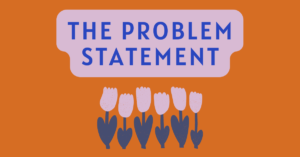
The Problem Statement is one of the most important sections of your Introduction chapter or section.
Why is it important?
A well-written problem statement shows your reader that you have grasped the essence of the research problem and its significance, identified a knowledge gap, and found a potential solution in the associated theoretical literature.
How long should it be?
Ideally, the problem statement should be a paragraph of ½ to ⅔ of a page.
What should it contain?
It should be a coherent summary of the earlier sections of the introduction chapter. And because it is largely a summary, there is usually no need to include references, as these will have been mentioned before.
Here is a template for the problem statement
Write 1-3 sentences for each of the following (in any order, but I suggest this order):
• Describe the background of the problem
• Describe the foreground of the problem (its perspective, significance and scope)
• Diagnose the problem and identify a potential solution in the associated theoretical literature
• Describe the knowledge gap, i.e., the relevant deficiencies in previous research
• Argue logically for the need for the study/generalise your claim to a wider audience.
Do you need help with your Problem Statement?
Contact [email protected]
Sources
This template is based on two of my favourite methodology books:
Badenhorst, C. (2007). Research writing: Breaking the barriers. Pretoria, South Africa: Van Schaik Publishers.
Van de Ven, A. H. (2007). Engaged Scholarship. Oxford, UK: Oxford University Press.
12. Construct the Purpose Statement

The Purpose Statement is your time to shine. This is the time when you can tell your reader exactly what you’ve designed your research to do.
Of course, the Purpose Statement must address the knowledge gap that you described in your Problem Statement. However, the Problem Statement is focused on the problem, and not directly on your research.
So the Purpose Statement is unashamedly about your research.
Here are a few pointers for framing your Purpose Statement:
Always start the Purpose Statement with “The purpose of this research is to…”.
In addition, Creswell (2018) advises that you provide details of the design, method and sample in your Purpose Statement.
Some examples:
The purpose of this research is to explore the views of ___ individuals on ___, using the ___ technique.
Or
The purpose of this research is to assess the impact of ___ on ___ by comparing perceptions of ___ before versus after the intervention of ___, in the Department of ___.
Or
The purpose of this research is to test and compare the explanatory power of two theories of ___. One theory posits ___, while the other theory posits ___. The theories will be assessed on a sample of individuals who are ___, using the ___ method of analysis.
You may use bullet points if your research has multiple purposes.
Do you need help with your Purpose Statement?
Contact [email protected]
13. Construct a Consistency Matrix
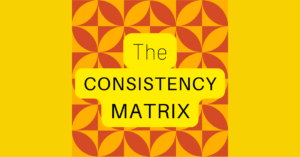
One of the joys of teaching is listening to students’ responses when they’re asked a question.
In the days of large in-student lectures, I would often direct a question to a sea of faces. Sometimes, an enthusiastic student would answer, beautifully, but completely off the topic.
And my response? “That’s a great answer, but to a different question.”
Unfortunately, a dissertation or thesis is not as kind or forgiving. You and your data simply have to answer the research question and sub-questions you have posed in your first chapter. And if you are framing hypotheses, you need to make sure that your data is sufficient to test them.
So, here is a tool to ensure consistency between your research question(s) and your data.
Construct a consistency matrix as in the following example:
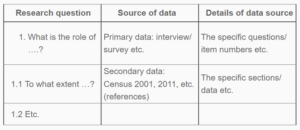
If applicable, you could add a column for the corresponding propositions/hypotheses.
This table is simple but powerful. It provides a structure for your analysis, discussion and conclusions, and makes marking easier for your supervisor and examiners. Of course, you may need to amend the details later, due to the flexible nature of qualitative research, or as you refine your measurement instruments in quantitative research.
The matrix may be placed within the methodology section of your proposal or dissertation, or as an appendix, should you choose.
Do you need help with your Consistency Matrix?
Contact [email protected]
14. Make sure your problem is a RESEARCH problem
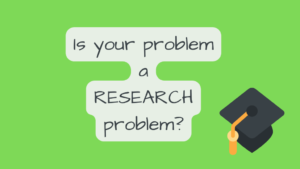
Whether you’re writing your proposal or the introduction to your dissertation or thesis, you will need to convince your supervisor or examiner that you’ve identified a researchable problem.
The trouble is that not every problem is a research problem.
Methodologists like Van de Ven (2007) provide guidance on how to distinguish between an ordinary problem and a research problem.
A problem becomes a research problem when you, as the researcher, identify the need for researching the issue by including the following four details:
- The perspective from which you’re examining the problem.
- The social, or real-world, significance of addressing the problem.
- Some potential resolution/diagnosis of the problem.
- The potential resolution/diagnosis that is based on the theoretical literature.
Do you need help with your research problem?
Contact [email protected]
15. Distinguish between measurement and research reliability
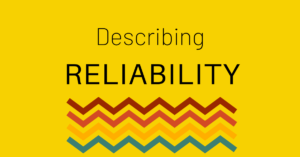
One aspect of research methodology that often confuses students is the topic of reliability.
This is because there are really two main types of reliability:
MEASUREMENT reliability and RESEARCH reliability.
These two reliabilities are very different.
Measurement reliability is all about assessing the reliability or consistency of the scores of your measurement instruments.
These assessments can take many forms: internal consistency reliability, test-retest reliability, parallel forms reliability, inter-rater reliability, etc.
Coefficient/Cronbach’s alpha fits in here as a measure of the internal consistency of the scores of a measurement instrument.
Research reliability is all about the reliability of your overall research.
This refers to the trustworthiness of your research and is based on your diligence as a researcher: the thoroughness of your recordkeeping, interview transcripts, your data cleaning methods, the completeness of your data and its description, etc.
Many studies have been retracted based on their research (un)reliability.
So, which aspect of reliability goes where in your document?
Describe your measurement reliability in the section of your methodology which requires you to describe your measuring instrument(s).
Describe your research reliability in one of the last sections, where you are evaluating your overall study.
Do you need help describing reliability in your study?
Contact [email protected]
16. Please don’t misuse Cronbach’s Alpha
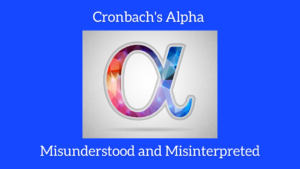
You may wonder why my sympathy for Cronbach’s Alpha (also called Coefficient Alpha).
Well, it’s because alpha is one of the most frequently misunderstood and misinterpreted statistics in theses, dissertations, proposals and other academic publications involving measurement 🥲.
SO, WHAT IS CRONBACH’S ALPHA?
Cronbach’s alpha is a measure of the internal consistency of a measurement instrument. It is the most commonly reported type of reliability.
If the internal consistency of a measurement instrument is low, then there is heterogeneity – or lack of consistency – among the items of the instrument, making it uncertain what the total score is measuring and implying the presence of random error in its scores.
WHY IS ALPHA MISUNDERSTOOD?
First, Cronbach’s alpha refers to the reliability of measurement, not the reliability of the overall research or study.
Second, some students doing qualitative interviews say they will calculate alpha for the questions of their qualitative interview instrument. Alpha can only be computed for a quantitative measurement instrument.
Third, internal consistency does not imply unidimensionality. A high value of alpha does not mean that all the items in an instrument measure the same thing. Rather, it means that every item in the instrument measures something similar to some of the other items, but the instrument may still be multidimensional.
Fourth, unless the measurement instrument is unidimensional (check this via factor analysis or similar), the total score may not be interpretable, even if alpha is high.
Fifth, don’t assume that an instrument with an alpha value of .7 indicates a sufficient measure of reliability or internal consistency. This value is arbitrary and increases with the number of items in the instrument.
Sixth, a very high value of alpha is not necessarily good as it may imply redundant items in the instrument that should be dropped.
Seventh, you cannot assume that published reliability values will apply to your own sample and test situation. You need to quote your own alpha value in addition to those published.
Finally, it is inappropriate to calculate the alpha value for a knowledge test made up of different facets, or dimensions. Calculate alpha per facet.
Do you need help describing the reliability of your measurement instrument(s)?
Contact [email protected]
17. Write your methodology well
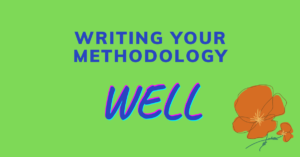
One of the most important aspects of the methodology section is to relate what you’re writing to your own research.
Students frequently reproduce pages of textbook definitions of research concepts e.g., research approaches, sampling, reliability, validity etc., with virtually no reference to their own research.
Let me show you an example of how many students (unfortunately) describe the research approach in their methodology chapter. These students typically devote over a page describing the research approach as follows:
Paragraph 1: Qualitative research is defined as ….. (reference).
Paragraph 2: On the other hand, quantitative research is ….. (reference).
Paragraph 3: Mixed research is ….. (reference).
Paragraph 4: This study used the quantitative approach.
However, what your supervisor, advisor and other examiners really want to read is what approach you’ve used in your research, why you’ve used it, and whether you can justify it based on the theoretical characteristics of that approach as opposed to others. They don’t want to read long extracts from textbooks using descriptions with no relation to your study.
So how should you relate the description of your research approach to your study? How about this?
The research approach to the thesis was entirely quantitative, as opposed to qualitative or a mix of the two (references). It relied on a detailed statistical analysis of the quantitative responses of a large sample of respondents to an online questionnaire designed to measure ___. As is typical of quantitative research, the statistical results relied on psychometric analysis of the scores of a closed-ended measurement instrument of ___, modelling of responses reflecting ___, and on analysis of data designed to estimate ___. At no stage were these processes measured qualitatively using self-reports or open-ended responses as would be the case in research using a qualitative approach (reference). The quantitative approach of the present research is consistent with the methods used in the associated literature on …. (references). It stands in contrast to the qualitative and mixed approaches used in studies which aim to ___ with a focus on ___ (references).
Of course, you would adapt your writing to your own approach, flesh out the paragraph further, and perhaps split it.
The main message here is that the student has related the research approach to their study, and also briefly contrasted this against the theoretical characteristics of various other approaches.
The same style works for describing other aspects of the research, for example, sampling, reliability, validity, etc.
Do you need help describing your methodology?
Contact [email protected]
18. Describe your sample

If you’re writing the methods section of your research, you will need to describe your sample. (I’m dealing here with the sample description, rather than the sampling method.)
So, how should you describe your sample?
According to APA guidelines, you should refer to people as ‘participants’, not as ‘subjects’. The term ‘subjects’ is used in animal research.
You need to report the demographic characteristics of your participants, such as age, sex, ethnicity, socioeconomic status, and any other characteristics important to your research, for example, their education level, etc.
I use a single, neat table to describe these characteristics. The table has a column for the key sample characteristics, and adjacent columns for the corresponding sample sizes and percentages. Try not to use any vertical lines in your table (APA doesn’t like vertical lines unless you really have to use them).
Next, I discuss the highlights of the information in the table. APA guidelines state that your discussion should supplement, not duplicate, the contents of the table.
And what should you not do?
You should not have lots of separate tables, pie charts and bar charts for each sample characteristic. Rather, summarise these in a single, elegant table.
You should also not have a screenshot of the raw data in your methods section.
Do you need help describing your sample?
Contact [email protected]
19. Are you planning an IMPACT study?

A frequent problem in students’ proposals and dissertations concerns IMPACT studies.
Clearly, impact studies are important. They allow you to assess change after the implementation of a new intervention, policy, initiative etc., to before it.
The crucial issue here is that to assess impact, you must assess CHANGE. And to assess change, you need to COMPARE the situation of relevance AFTER the intervention to BEFORE it (or vice versa).
And this is where the problem arises. Many students don’t consider the before situation, only the after.
Without a pre- versus post-comparison, you can’t measure impact.
So how do you get around this if you don’t have indicators of the situation before the intervention, or you never thought of this?
One way out (although not ideal), is to ask your respondents after the intervention for their PERCEIVED impact of the change. For example, have questions about how much more/less efficient they find a certain process now, compared to before the intervention. In other words, you measure them once (after the intervention), and ask them about the change they perceive. Here, you would probably have a descriptive study describing the perceived impact.
Another way out is to find a comparison situation – some similar situation, but in which the intervention wasn’t introduced. So, here, you would be comparing your situation where the intervention HAS occurred, to another comparable situation where the intervention HASN’T occurred. You would have to motivate strongly for the feasibility of the comparison situation (good luck). And it would be questionable whether you could infer a causal relationship in this quasi-experimental study design.
So, in a nutshell, if you’re planning an impact study, make sure you have indicators before the intervention, and the same indicators after.
And then you’re good to go
P.S. Just to clarify this post, I’m referring to studies assessing the impact of interventions after they have happened. I’m not referring to Environmental Impact Assessments which assess the likely implications of proposed actions before they are implemented.
Do you need help with your research design?
Contact [email protected]
20. Distinguish between Delimitations and Limitations

Whether you’re writing your dissertation or proposal, you’ll need to specify the Delimitations and Limitations of your research. Here is a description of the differences between them.
DELIMITATIONS are what you decide upfront will be the boundaries, restrictions or fences of your research.
For example, you may decide to restrict your population or sample, or to restrict the time period of your study, its geographic location, the theories you’re modelling, or some other boundary.
In effect, you purposefully ringfence the scope of your research to make it feasible, or more manageable.
LIMITATIONS, however, are weaknesses in your research that you need to acknowledge. These are not boundaries that you set upfront, and are not directly under your control.
For example, in your proposal, you might say that your research design is limited as it does not involve experimental manipulation, or your results are not generalisable as you’ve used the qualitative research approach, or nonprobability sampling.
Later, when you’re writing the dissertation, you may have to add further limitations. For example, your research results may be limited because the scores of your questionnaire turned out to be less than reliable (let’s hope not!), or because you failed to recruit a large enough sample size for adequate statistical power (let’s really hope not!).
Do you need help describing the delimitations and limitations of your study?
Contact [email protected]
Sources
Cortina, J. M. (1993). What is Coefficient Alpha: An examination of theory and applications. Journal of Applied Psychology, 78(1), 98-104.
Cronbach, L. J. (1951). Coefficient alpha and the internal structure of tests. psychometrika, 16(3), 297-334.
Gardner, P. L. (1995). Measuring attitudes to science: Unidimensionality and internal consistency revisited. Research in Science Education, 25(3), 283-289.
Kline, R. B. (2011). Principles and practice of structural equation modeling. New York, NY: The Guilford Press.
Revelle, W., & Condon, D. M. (2019). Reliability from α to ω: A tutorial. Psychological Assessment, 31(12), 1395–1411. Retrieved from https://doi.org/10.1037/pas0000754
Taber, K. S. (2018). The use of Cronbach’s Alpha when developing and reporting research instruments in science education. Research in Science Education, 48, 1273–1296. Retrieved from https://doi.org/10.1007/s11165-016-9602-2